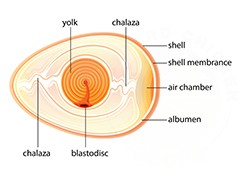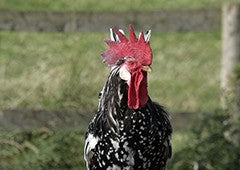There is a lot of chicken jargon that gets thrown around, which can be quite confusing, especially if you’ve never owned chooks before. One of the first peculiar terms new chicken enthusiasts encounter is “pullet”. In context it often seems as though people are referring to younger chickens, but aren’t these called “chicks”. Perhaps there is some sort of clue in the word, “pull-et”… “pull-it”… “pull it” – but what should I be pulling? Rather than over thinking things it might be best to read these 7 Chicken Lady wisdoms about pullets that will surely help you on your chicken keeping journey.
1. Pullets are essentially chickens that are less than one year old.
This may seem like a simple definition but there are definitely some clauses that you need to pay attention to. A chicken from one day old to 15 months can be considered a pullet, which of course does not account for chicks, but it’s best just not to think about that. A pullet officially becomes a hen after its first moult, which can occur either quite early or quite late in the first year of their life. The confusion in the terms seems to be connected to the fact that chickens used to only be hatched during the spring and summer months however now chickens are bred pretty much all year round, which in turn creates a creates greater diversity and confusion about when chickens are "supposed" to moult for the first time. In a eggshell, a chicken can be considered a pullet for about a year or until it temporarily loses all its feathers during a moult, which for some lucky hens – I mean pullets – usually occurs between the first 3 to 15 months of its life.
2. The pullet year is considered the most productive laying period for chickens.
Once the pullets have its first moult, and technically become hens, they tend to produce larger but fewer eggs. In older times some poultry farmers would find other uses for their chickens after the first year, favouring the rapid egg production of young pullets. Some people become alarmed when their chickens start producing fewer eggs however it is a perfectly natural process as old as time itself. If you prefer to always have a dozens upon dozens of eggs at the ready, perhaps it’s best to always have some young pullets in your flock, but be sure that your non-laying hens are not pushed to one side – either embrace them fully as pets or humanly give them to someone with enough space to accommodate some more mature chooks.
3. Pullet eggs are incredibly small and kind of cute.

As you might expect, the first eggs your pullets lay are actually adorably small. This is in large part due to the fact that the chicken’s egg maker is still forming. The size of a pullet's eggs will gradually increase over the first few days of their laying life. Rest assured cute little pullet eggs are still perfectly edible and it might actually be fun to hard or soft boil them and take a few pictures.
4. You won’t be able to tell if some pullets are boys or girls.
To clarify, a pullet is a female chicken between one day to 15 months old and a cockerel is its male equivalent. When they are very young pullets and cockerels will almost look identical. There are in fact chicken sexers employed by some breeders to rapidly separate the boys from the girls by examining the inside of their vents. Without getting into too many graphic details, very accomplished chicken sexers can determine the sex of chicks most of the time, but there are some chooks that simply do not conform sex or gender when they are young. So, try to have some understanding if you buy some point of lay pullets that turn out to be cockerels from a breeder – it is a genuinely difficult and occasionally messy job. For more information about sexing chickens just click here.
5. Not all pullets are going to start laying at the same time.
In the same way that some humans are late or early bloomers, not all pullets are going to start laying eggs at 18 weeks. Some chickens will take as long as 24 weeks before they even consider laying an egg, while other more feisty chickens can’t wait to get to work and start laying by 16 weeks. In large part this is determined by their breed and genetic history. Also, providing them with plenty of nutritious and healthy chicken feed definitely doesn’t hurt. If you want to know about encouraging a long and productive lay cycle just click here.
6. Mix your chick feed and big girl feed together.
Your baby chick and pullet feed doesn’t have to go to waste once your girls are ready to lay. Lots of chicken gurus mix the baby chick feed with the older chicken feed, around the time the pullets are 15 weeks old. This helps prepare their bodies for egg laying, whilst not shocking or overwhelming their system. It’s also a great way to save money on your chicken feed budget.

7. Keep an eye on their combs and wattles.
Combs and wattles are a good indicator of when your girls are going to start laying. Typically a pullet’s wattles and comb with develop a deep red swollen colour around the time they are getting ready to lay. If you notice this in your pullets than it’s time to pop the champagne and prepare yourself for an egg fiesta!
One thing is for sure though, whether you’re raising sassy pullets or serene non-laying hens, every bird in your backyard loves to come home to a safe and secure coop, like the Taj Mahal, Penthouse or Mansion. Be sure that your pullets have a castle they can lay in during that eggstremely productive first year of life.
From chicks, to pullets, to egg-layers, as chicken keepers, we all want to do an eggcellent job when caring for our feathered friends at all ages. There are just so many things to consider when becoming a chicken parent from health to nutrition. Many chicken keepers struggle to handle chicken health or behaviour issues, especially in the first few years of having a flock.
This is why I recommend Chickenpedia to all my readers. They have comprehensive online courses on everything you didn’t know you need to know and then some more! From healthcare to raising baby chicks to feeding and behavior, you’ll find beginner-friendly courses that’ll give you the knowledge and confidence to successfully look after your chickens.
As a member, you will get access to ALL their fantastic courses. No need to wing it, become the ultimate chicken eggspert! Check out Chickenpedia today!


















